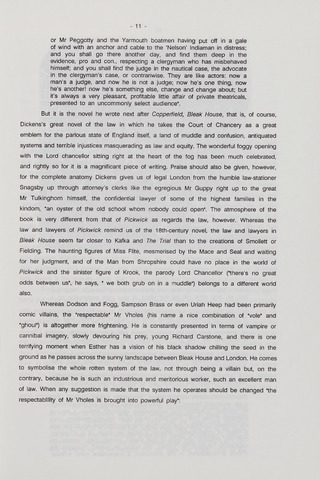- 11 -
or Mr Peggotty and the Yarmouth boatmen having put off in a gale
of wind with an anchor and cable to the 'Nelson' Indiaman in distress;
and you shall go there another day, and find them deep in the
evidence, pro and con., respecting a clergyman who has misbehaved
himself; and you shall find the judge in the nautical case, the advocate
in the clergyman's case, or contrariwise. They are like actors: now a
man's a judge, and now he is not a judge; now he's one thing, now
he's another! now he's something else, change and change about; but
it's always a very pleasant, profitable little affair of private theatricals,
presented to an uncommonly select audience".
But it is the novel he wrote next after Copperfield, Bleak House, that is, of course,
Dickens's great novel of the law in which he takes the Court of Chancery as a great
emblem for the parlous state of England itself, a land of muddle and confusion, antiquated
systems and terrible injustices masquerading as law and equity. The wonderful foggy opening
with the Lord chancellor sitting right at the heart of the fog has been much celebrated,
and rightly so for it is a magnificant piece of writing. Praise should also be given, however,
for the complete anatomy Dickens gives us of legal London from the humble law-stationer
Snagsby up through attorney's clerks like the egregious Mr Guppy right up to the great
Mr Tulkinghorn himself, the confidential lawyer of some of the highest families in the
kindom, "an oyster of the old school whom nobody could open". The atmosphere of the
book is very different from that of Pickwick as regards the law, however. Whereas the
law and lawyers of Pickwick remind us of the 18th-century novel, the law and lawyers in
Bleak House seem far closer to Kafka and The Trial than to the creations of Smollett or
Fielding. The haunting figures of Miss Flite, mesmerised by the Mace and Seal and waiting
for her judgment, and of the Man from Shropshire could have no place in the world of
Pickwick and the sinister figure of Krook, the parody Lord Chancellor ("there's no great
odds between us", he says, we both grub on in a muddle") belongs to a different world
also.
Whereas Dodson and Fogg, Sampson Brass or even Uriah Heep had been primarily
comic villains, the "respectable" Mr Vholes (his name a nice combination of "vole" and
"ghoul") is altogether more frightening. He is constantly presented in terms of vampire or
cannibal imagery, slowly devouring his prey, young Richard Carstone, and there is one
terrifying moment when Esther has a vision of his black shadow chilling the seed in the
ground as he passes across the sunny landscape between Bleak House and London. He comes
to symbolise the whole rotten system of the law, not through being a villain but, on the
contrary, because he is such an industrious and meritorious worker, such an excellent man
of law. When any suggestion is made that the system he operates should be changed "the
respectablility of Mr Vholes is brought into powerful play":

